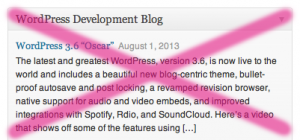![]() WordPress is made up of over 70 files which may be called to display your site. Dreamweaver has a handy feature with which it lets you discover all those files.
WordPress is made up of over 70 files which may be called to display your site. Dreamweaver has a handy feature with which it lets you discover all those files.
Sometimes this works great – and sometimes you get the error message above. I was stumped by this when a site I was working on seemingly threw Dreamweaver overnight. Was was going on?
The secret is Permalinks.
Dreamweaver has a problem discovering and resolving related files if you’ve set Permalinks to anything other than the default. This problem has been around for a while, ever since the introduction of this feature in fact.

 If you want to never see a widget on your WordPress Dashboard ever again, just head over to the top where it says “Screen Option”, then simply un-tick the ones you don’t like.
If you want to never see a widget on your WordPress Dashboard ever again, just head over to the top where it says “Screen Option”, then simply un-tick the ones you don’t like.  There’s a great little plugin called Add Logo to Admin by c.bavota which does a great job at letting you add your own logo to the WordPress login screen, and even to the top of your dashboard. But it’s another plugin.
There’s a great little plugin called Add Logo to Admin by c.bavota which does a great job at letting you add your own logo to the WordPress login screen, and even to the top of your dashboard. But it’s another plugin.